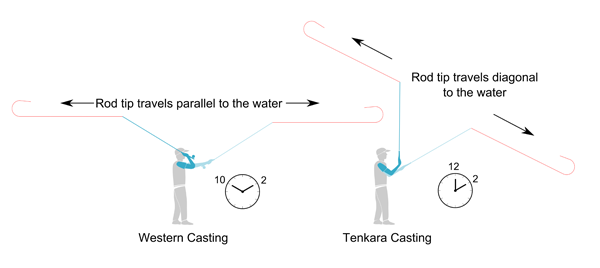A lot of people that come to tenkara are already western fly anglers familiar with the 10 O’clock/2 O’clock casting stroke. While this may be a comfortable casting style, it doesn’t really translate well to tenkara and some wonder why they can’t cast a tenkara rod well with their normal casting style. There are some fundamental differences between western and tenkara casting that one should be aware of in order to cast a tenkara rod well. Let’s take a closer look at one of the most important.
In the diagram above, you’ll notice that in the western 10 O’clock/2 O’clock the rod tip travels in a straight path that is more parallel to the water. The fly stops above the water and is “landed” on the surface after the line straightens out. In many cases, the fly and line land on the water at the same time.
With a tenkara cast, the fly hits the water first and the line is suspended out of the water. This is achieved by making the tip of the rod travel in a path more directly targeted at the water (instead of above it). Notice in the diagram how the rod tip travels in a more diagonal path that is angled down at the water. The backcast is stopped at 12 O’clock while the forward cast is still stopped somewhere around 2 O’clock.
For beginning tenkara casters, it’s tempting to bring the back cast back too far. Of course, there are other differences with western casting the I will go over in future posts. But understanding this basic concept will help you transition to the less familiar tenkara casting style.
Here is a good video demonstrating the tenkara casting stroke:
Special thanks to Anthony Naples for making this graphic for me. Though if that western fly guy were casting that close to me, there’d be trouble!









Good post. The people I see who have the most problems, though, have it with taking their forward cast too low – stopping at 3 rather than at 2.
One thing that Lefty points out in his casting demos (and whatever he thinks of tenkara, you gotta say the man knows how to cast) is that the line follows the rod tip. If you end your cast at 3 rather than at two, the direction the rod tip takes from 2 to 3 is almost straight down. Sure enough, the line goes almost straight down and piles up 5′ in front of the caster.
I think one of the biggest keys is to stop the rod at 2, and as the line is unrolling, slightly raise the rod tip, which will further encourage the line and tippet to fully turn over.
Chris, good point about slightly raising the rod tip at the end of the forward cast. If you watch any videos of the masters casting, they do this. They kind of “bounce” the rod tip at the end.
I liken the “bounce” that you speak of to the nympher’s “tuck” or “check” cast tecnique to drive the fly into the water before the line hits. I beleive it is Joe Humphreys that talks about a nymphing cast that he calls an “up-downer” which is used for nymphing, and coincedentally is very similar to the tenkara casting as you describe it. I think that tenkara anglers can learn a lot from western nymphing techniques in general.
Good post, I find that my casting is so much based on experience and intuitive feel – I just adjust things until the fly does what I want it to do. This works for me as I’m sure for many other experenced anglers. However it can leave me at a loss when attempting to explain it to others. I tend to not think in “words” but only in results. So it’s nice to have a way to explain the basics to someone in simple terms.
or otherwise referred to as the “swoop”, and various other images used by casting teachers….
BTW, lefty casts wiv ‘is thumb on top and still does.
on an unrelated note, I was surprised about the length of time in the video that was spent fishing to very low percentage water in the shallow middle of the run(as soon as the video panned up I put my finger on the screen and said there, and sure enough, that where the fish came – obvious holding for two to five fish in the deeper run after a oxygenated drop). but I accept that perhaps the point was more about demonstrating casting to pockets, rather than fishing strategies – I’m not too proud to admit that whoever it was casts a tenkara rod better than my western trained reflexes ever will.
It is funny, because here in France many people are casting the western style you describe, BUT the way that is teached by the French “Official” Fly teachers (FFPML : http://www.ffpml.com/ ) is the “French linear casting”, which looks exactly like the Tenkara casting on your drawing.
Basically in this casting form, your casting hand moves along a straight line, starting and stopping 12 and 2 with any rotation replaced with hand translation. in he top position the hand is at ear level, so on the backcast the line moves below the rod tip, on the forward cast the line moves above the rod tip, always in the same plane.
It is weird at first but very efficient, and requires very little strength
Just to share 😉
Muy buen post,muy educativo…muchas gracias…!!!